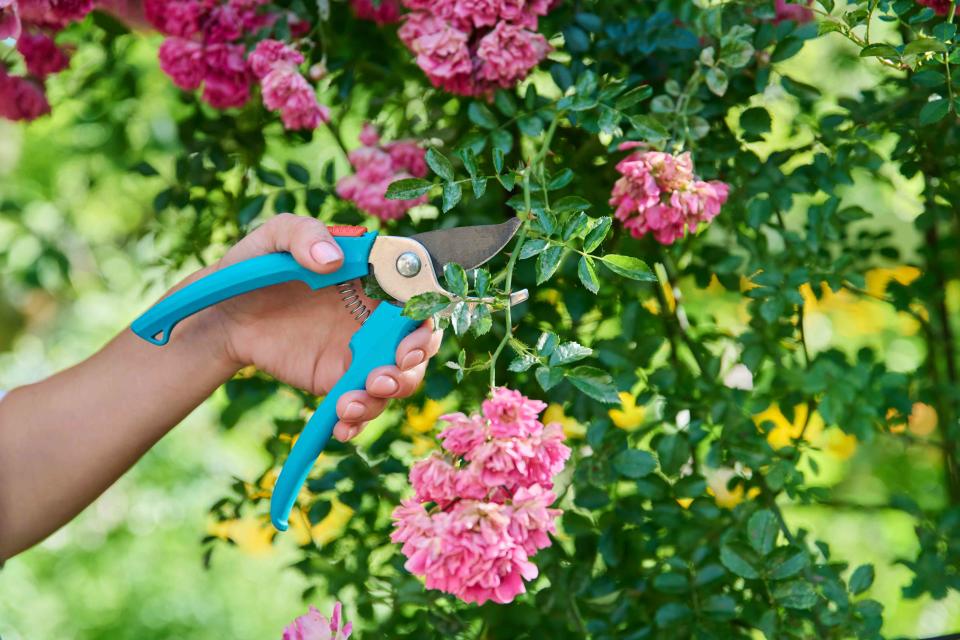What Is Pruning—and When Do You Need to Do It?
It's a must-do if you have a garden—or even a few houseplants.

Valeriy G/Getty Images
Bigger isn't necessarily better when it comes to plants. That's where pruning comes in—to improve your tree's or plant's health, and help control and shape growth. But how—and when—should you be pruning your plants or trees? And how does cutting back your plants actually encourage them to grow back bigger and stronger?
Learn the basics about pruning—from what it is to how and when to do it.
Related: 9 Gardening Tips for Beginners
What Is Pruning?
Pruning is carefully cutting back branches or stems from your plants or trees to improve its health, increase the number of blooms, and shape it to fit your garden space effectively.
It involves not only cutting out diseased, damaged or dead branches, but also looking to thin out growth to allow bottom branches to get sunlight, keep unwieldy branches from blocking pathways, and cutting away branches that might be prone to disease.
What Tools Do You Use to Prune Plants?
Pruning plants can require a few different kinds of garden tools, depending on the types of plants you're pruning. For small shrubs and plants, a bypass pruning shears—a scissors-like tool—can handle branches under an inch wide. Hedge shears, which have thick handles and long, scissors-like blades, are used to shape shrubs. A lopper has a long pole with a blade attached, and is great for cutting larger and hard-to-reach branches. You might also want a pruning saw, which has a long, curved blade and can be used for branches closer to the ground.
Keep your pruning tools clean
Pruning tools should be cleaned with either bleach, isopropyl alcohol, or hydrogen peroxide. If your plants are all healthy, you can clean them as needed, but at least once per year. If you're pruning off unhealthy parts of a plant that are infected with powdery mildew, blight, or other common plant pests, you should clean them before you move on to healthy parts of the plants or other healthy plants to avoid spreading the disease.
How to Prune Plants
Pruning plants isn't difficult, but you'll want to be careful to follow the instructions for your particular plant to ensure that you aren't weakening your plant by cutting it back incorrectly.
Know the proper timing
The optimal time to prune and deadhead your plants and trees depends on the particular plant or tree.
You can remove dead or diseased branches whenever you see them, and spent and dead blooms to help your garden look gorgeous.
Know your varietals
Pruning instructions can vary within a plant type—for instance, some butterfly bushes need pruning, while others don't. You'll want to look at what's suggested for your particular garden plants to ensure that your plants thrive.
Many plants should be pruned in late winter or early spring, to help promote new growth. During the summer, you'll likely only need to deadhead spent blooms on flowering bushes and plants, or prune back plants that are done blooming for the season.
One time when you should avoid pruning: the late summer to fall time frame. New growth created then may not be hardy enough to survive the winter, and any cuts may not have time to heal, leaving your plant open to disease.
Start small
Just like when you're trying to cut your own bangs, it's best to start a little at a time—you can always go back and trim more afterward.
Go for the obvious trims
The first cuts are pretty obvious—any dead or damaged branches, yellowed or dried-out leaves, and spent blooms.
Next, look at the structure of the plant. Look for uneven areas of growth that feature too many branches, where you may want to thin out the plant to allow sunlight to reach the lower parts of the plant. Branches that overlap and rub against each other should also be trimmed, to avoid wear spots that can allow pests or disease to infiltrate your plant.
Again, follow your individual plant's pruning requirements. Some plants require significant pruning—almost to the soil line—while others require cutting back a third of the growth.
Cut at the appropriate spot
You want to cut back to a growing spot, such as a leaf node or where another branch forks off from the branch, or down to the soil line.
What Plants Need Pruning?
Some plants require seasonal pruning—such as pruning in early spring or late winter—while others may require regular maintenance to remove spent blooms or excessive growth. Check out a few of the most common garden plants that need regular pruning—and when to put that on your to-do list.
Butterfly Bush (late winter or early spring)
Crepe Myrtle (late winter)
Forsythia (late spring)
Fruit trees (mid-winter)
Hydrangea (spring for mop-head hydrangeas, summer for lacecap hydrangea)
Lilacs (spring after blooming)
Perennial Flowers (generally after the bloom season is done, but check your variety)
Roses (depends on the variety)
What Plants Don't Need Much Pruning?
Some plants don't require much pruning to stay healthy, so feel free to let them be, unless you want a particular shape, need to trim back branches that block pathways or other plants, or there's a branch or bloom that's dead or shows signs of disease.
Some plants that don't require regular pruning include:
Spotted Laurel
Creeping Juniper
Deciduous Azalea
Holly
Manzanita
Myrtle
For more Real Simple news, make sure to sign up for our newsletter!
Read the original article on Real Simple.

 Yahoo Lifestyle
Yahoo Lifestyle 
